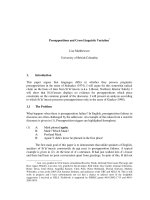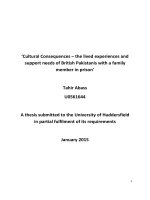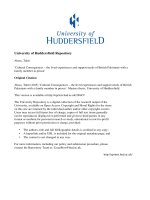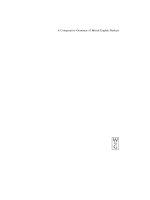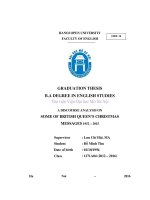Coloured illustrations of British birds, Meyer 1847
Bạn đang xem bản rút gọn của tài liệu. Xem và tải ngay bản đầy đủ của tài liệu tại đây (15.35 MB, 340 trang )
COLOURED
ILLUSTRATIONS
OF
WxitiW Mitti^
AND THEIR
©ggs*
BY
H. L.
VOL.
MEYER,
IV.
CONTAINING SIXTY PLATES.
LONDON:
SIMPKIN, MARSHALL, &
1847.
Co.
LONDON:
Bentlet, Wilson, and Flet.
Bangor House, Shoe Lane.
Printed by S
J.
CONTENTS
THE FOURTH VOLUME.
PLATE
PAGE
Barred Woodpecker
136.
1
Wryneck
137.
7
Nuthatch
138.
14
Tree Creeper
139.
19
Hoopoe
Cuckoo
American Cuckoo
140.
25
141.
31
142.
35
Wood
143.
37
.
Pigeon
Stock Dove
144.
43
Rock Dove
Turtle Dove
145.
49
146.
56
Passenger Pigeon
147.
61
Pheasant
148.
65
149.
71
Cock
of the
Wood
Black Grous
150.
76
Red Grous
151.
81
Ptarmigan
152.
84
Partridge
153.
89
Red
154.
97
155.
100
legged Partridge
Barhary Partridge
.
Virginian Partridge
156.
102
Quail
157.
109
Andalusian Hemipode
158.
112
Great Bustard
159.
114
Bustard
160.
121
Crane
161.
124
Great White Heron
162.
133
Little Egret
163.
137
Heron
164.
140
Little
.
Purple Heron
.
Buff-backed Heron
Squacco Heron
.
Bittern
Little Bittern
.
American Bittern
Night Heron
.
Stork
Black Stork
.
Spoonbill
Ibis
Curlew
.
.
Whimbrel Curlew
.
Spotted Redshank
Redshank
Green Sandpiper
.
PLATE
PAGE
165.
145
166.
149
167.
150
168.
154
169.
170.
161
167
171.
169
172.
173
173.
177
174.
183
175.
187
176.
192
177.
197
178.
203
179.
208
180.
213
;5b.
•
m
~
v?-;'/
.'.-
'^Im
ILLUSTRATIONS
OF
BRITISH
BIRDS.
PICIDM.
INSESSORES.
SCANSORES.
PLATE CXXXVI.
BARRED WOODPECKER.
Picus minor.
The
Barred
Woodpecker
{Linn.)
the smallest of the wood-
is
peckers hitherto found in Britain, and
generally
supposed
but owing to
;
restless
activity of its habits,
by the
foliage of the
sustenance.
its
species
in
;
we
it
is
not
ourselves have
and beech
trees,
small
size,
amongst which
it
Mr. Yarrell
and
uncommon
met with
it
and the
labours
apple-tree.
of this species resemble those
of
gives
The
its
for
this
us
in the vicinity of
in
is
hidden from view
to
Lon-
Surrey amongst elm
at
work on the
habits
and manners
and not unfrequently hard
mossy branches of an
void IV.
not so rare as
Mr. Selby speaks of having met with
Hertfordshire,
understand that
don
trees
its
easily
is
it
is
family previously de-
B
PICIDE.
'Z
scribed; he
very lively and nimble, running up and round
is
the stems of trees, and also on and along the under sides of
the smallest horizontal branches with great ease and celerity.
When
ascending the trunk of a tree he will at times run
down
backwards
head upwards.
the
again,
but he
As an
engineer, for excavating a hole for
always descends with the
purpose of his night's habitation, or for containing a
nest for the reception of the eggs, he
Woodpeckers
of the larger
ance
;
that
is
is
surpassed by none
in ingenuity, skill, or persever-
and although he usually chooses the
to
be found
softest material
operations, yet he will not
for his
monly be discovered making
uncom-
under surface of
his hole on the
a horizontal forked branch of an old oak tree.
Sometimes the Barred Woodpecker may be seen perched
on the branch of a
tree,
like
other
grasping
toes,
and
if
it
with his
so
of his
birds
he
will
family,
be found to
have his legs closely drawn Up to his body, probably
Among
the purpose of balancing himself steadily.
species,
he
and jealous,
unsociable
as
is
and
for
own
his
selfish,
as
regards his food and worldly possessions as the foregoing,
and
this
seen
in
and
accounts for the circumstance of his never being-
company,
during
except
after that period with its
rives
for
creepers,
them
to
be
about
sent
the
breeding
their
business.
seen to follow in
the
wake of
this
woodpecker,
the latter takes no notice whatever of them.
may be
nor
of
not at
is
all
although
As
the bird
shy or fearful of mankind, he
readily approached sufficiently near for observation,
does he
fly
away
for short distances.
woodpecker
in the air
again
Tree
and golden-crested wrens are frequently
titmice,
now spoken
season,
offspring until the time ar-
by
in
for
His
some time, but continues to hop
flight
undulating
resembles that of the spotted
progress,
by drawing the wings
lowering his position
close to the body,
and
rising
flapping the wings in quick succession while they
BARRED WOODPECKER.
The-call note of the Barred
are extended at full length.
Woodpecker
an often-repeated, rather
is
drawn keek, keek, keek, keek
having flown some
wing
;
This
!
distance,
little
and long
shrill,
he utters after
call
but rarely when on the
and during the pairing season he
some
tree frequently repeating his call,
ening
its
sits
on the top of
and gradually short-
expression during the continuance of each strain.
In the spring of the year the male of
brates a branch of
and
g
for the
some
tree in the
same purpose
to its smaller size
he
this species also vi-
manner before described,
but owing
as the foregoing species,
is
obliged to beat a branch of less
magnitude, and consequently the sound produced
The
loud.
restless
very apparent while the bird
whilst
driving
a continual outcry
The
summer
during which times
food of the Barred
or winter, but
In pursuit of
ants or their larvae.
trunks
kept up.
is
or while fighting
or rival,
consists entirely of insects, as nothing
in its stomach either in
the
not so
in pursuit of his partner, or
is
away an intruder
for his right to a chosen hole in a tree,
Woodpecker
is
and jealous habits of the species become
he climbs up
this food,
and amongst the branches of
found
is
spiders, beetles,
trees, preferring
those of lesser size, owing to the bark of these being easier
to remove.
Plum and
insects of this bird, to
visitor.
The
scent of
apple trees contain
which he
is
many
favourite
consequently a frequent
this bird nearly approaches to that
of musk.
The Barred Woodpecker
some
tree, either
builds
its
nest
in
a
hole
an old habitation, or one made by
it
in
for
the occasion, at an elevation of from ten to sixty feet from
the ground.
by a
in
The
carpenter,
hole
is
as
perfectly
round
as
if
made
and not more than an inch and three quarters
diameter and
six
inches
in
depth.
These birds
fre-
quently begin several holes and leave them unfinished, and
sometimes even complete more than the one they occupy,
b2
i
picid.e.
The
probably the better to escape observation.
or six in
number, are deposited
and shavings
they are of the most delicate texture, of a pure
;
white, with the yolk shining plainly through.
days' sitting, the parents are gladdened
by
After fourteen
the appearance of
young brood.
their
This Woodpecker
an inhabitant of most parts of the
is
middle and north of Europe, but rarely seen
and
eggs, five
the hole on a few splinters
in
Wooded
Holland.
very rare in
is
in
the south,
countries are
his
from necessity, not caring, however, what species of
choice,
Like other woodpeckers, he
trees constitutes them.
found
is
parts of the before-named localities, but usually only
in all
seen alone, and
The
is
consequently considered uncommon.
more frequently some
in length, or
he measures, from the
The
inches.
Woodpecker
of the Barred
size
tail
woodpecker, but of course
six inches
and
width
in
one wing to the other, twelve
tip of
constructed
is
about
is
lines less,
like that
of the
smaller, in proportion
is
spotted
to the
size of the bird.
The wings
hinder parts
short,
are rather pointed in
the
;
first
the fourth and
and second
fifth
but broad at the
front,
quills
the longest
in
in
the wings are
the wings
;
the
secondaries are very broad and rounded abruptly.
The beak
weaker than that of the great spotted
small,
is
the upper surface, and
woodpecker, sharply ridged on
angular,
straight
two
in length,
lines
lead coloured,
The
coloured.
and chisel-pointed, measures seven
and a half high, and three
black at the tip
The
iris
long
The
chin
is
also
of the young bird
blood red.
lines broad
;
of the beak flesh
inside
nostrils are oval shaped, placed in a groove,
and covered with strong brown
are black.
;
tri-
lines
The tongue
horny-pointed
tip,
is
bristles,
the tips
of which
covered with similar
bristles.
chestnut, and in the adult bird
of this
species
is
furnished with
a
armed with barbs, and supplied
;;
BARRED WOODPECKER.
with a glutinous substance, and
beyond the
ten lines
The
tip of the
its
O
when extended,
length,
beak.
and apparently weak
legs of this species are small,
the tarsi are feathered two-thirds of their length
and the remaining part
front,
are
neath
claws
the
;
is
on the upper
scaled
also
neither
are
coarsely scaled
the
the
toes
;
and warty
surface,
large,
down
under-
nor
strong,
sharp
the legs and claws are lead coloured, with the tips of the
claws black, and the
soles
The
of the feet yellow.
adult
male has the forehead, regions of the eyes and mouth, brownish
yellow
from the forehead
;
to the
back of the head there
is
a beautiful space of carmine red, palish towards the forehead,
and darker towards the nape
which
black,
black
triangular patch
neck
edged with
are
forming
backwards,
continued
is
the
in
the sides
;
with
the
a
downwards,
point
The back
and the rump
and thus running into the black on the back.
itself
barred
white,
is
and
tail
the
eyes
with
across
black,
A
coverts are also black.
white streak runs over
and along the temples, extending
over
all
the
sides of the neck.
From
the
corner
of
mouth
the
commences
dark
a
mustachio, scaled alternately with black and white, becoming
black
all
as
proceeds, and ending in
it
a
triangular
black spot below the ears, the lower angle of which loses
dusky
itself in
bird
white,
are
tail-coverts
black
spotted
of the
All the under parts of
streaks.
tinged
The wings
ings.
the
are
shaft
are
with
wood brown, and
with
heart-shaped
black,
head and
although
entirely black,
on the
streaks
tip
;
and
under
mark-
more dusky than
quills
The middle
form
five
or six
tail-feathers are
the next and the third have white markings
the fourth
tip
the
dusky
and the square white
back,
markings on the outer webs of the
white bars across the wings.
this
is
only black on the roots, with black
on a white ground
;
the fifth pair are all white
6
PIC1D.E.
with
five
black bars, and the small outer feathers are black
with one white spot near the tips
are
dull black
;
the under parts of the
tail
The wings below
are
and yellowish white.
greyish black with white bars
;
and the under wing-coverts
silky white, with a few oval-shaped greyish black spots,
one deep black spot under the finger
wants the carmine coloured patch, the black
and
less
The
The
quill.
is
and
female
more rusty
deep, and the white less pure.
egg
Woodpecker.
figured
No.
136
is
that of
the
Barred
;
WRYNECK.
INSESSORES.
SCANSORES.
PICIDJE.
PLATE CXXXVII.
WRYNECK.
Yunx
The Wryneck
;
and
in bodily construction, manners, habits,
This bird
respects.
and Africa
{Linn.)
forms the link between the woodpeckers
and the tree-creepers
and other
torquilla.
found
is
in
Europe, Asia,
Europe has been met with
in
in Greece,
Italy, Spain,
Germany, Denmark, Sweden, Norway, and even
in Lapland,
but being migratory,
known European
only
in
is
only an
species,
and
it
This
the
females.
It
has
many
is
the
usually visits Britain
the spring, remaining with us until August,
been observed that the males always
of
inhabitant
summer months.
the colder climes during the
and
it
has
arrive a few days before
provincial
names
in
England,
such as the Snake Bird, (from the markings on the head and
back,
and
the curious habit
its
head and neck,
by
it
or
when disturbed
Cuckoo's
it
as well as
has of twisting and turning
from the loud hissing made
and the Cuckoo's Mate,
in its retreat,)
Messenger,
in
consequence
being the forerunner of the cuckoo,
the
latter
is
never heard before
it
the
its
generally
being affirmed
Wryneck,
Wryneck seldom more than a day or two
The locality chosen by the Wryneck is
interspersed with
of
nor
that
the
before the cuckoo.
a
meadows and hedge-rows,
woody country,
or
underwood
PIC1DE.
8
an open
or
groups of
of willows
dry
in
country containing
irregular
and unconnected
such as orchards or plantations, particularly
trees,
and he prefers low moist lands before high and
;
so that in
localities,
and about the
mountainous
He
valleys.
districts
he
only seen
is
seemingly also prefers trees
may be
of a middle size to those that are more lofty, and
frequently seen perched on the lower branches,
on the uppermost boughs of a tree
;
and
but rarely
as his food princi-
pally consists of ants, which he takes from the ground, he
is
most usually found
in low bushes or hedge-rows,
The
the surface of the ground.
neck in some hole of a
is
as his
beak
is
on
Wry-
passed by the
which purpose old pollard
most readily furnish him with a lodging
trees
him
night
tree, for
or
particularly
;
not formed with sufficient strength to enable
to excavate a cavity for himself,
and he
is
therefore
com-
pelled to resort to the deserted hole of a woodpecker, or any
chance hole that
The Wryneck
may
is
present itself to supply his wants.
quarrels with his neighbours,
two male birds
by them
which
in a
who never
a very harmless and quiet bird,
and even the dispute between
for the possession of a
few chasing
flights,
female
and a
is
earned on
calling
little
out,
up while the
latter portion of the contest is followed
disputants are perched at a short distance from each other on
separate branches in apparent passion, with the
the head and throat
little
or
only
fly
no
fear of
much
distended and raised
man, and
if
to a short distance.
on a branch he always
sits
feathers of
;
they show
surprised while on the ground,
When
the
Wryneck
perches
transversely thereon, neither does
he run up the trunk, or along the horizontal branches of a
tree in the
manner of the woodpeckers, but always progresses
in a half-sideling posture,
feathers
;
stem of a
as if careful not to ruffle his tail-
and when he fastens himself upright against the
tree,
he never moves
Perched on a branch
onwards in
that
position.
his posture is rather upright,
but on
•
WRYNECK.
9
the ground he hops about with his knees very
much
bent,
and with long leaps, generally keeping among long grass or
weeds in pursuit of
At
his food.
times the bird
about
now
first
a great length, and then moving
or turning
it
body slowly and
or
remarkable
that
this
it
amusing
been observed to do
feat,
at the
same time making
of mature
call note, cue, cue, cue, cue, is frequently
the sounds
well as
the call of the
hobby
duced a young brood
is
of
expression
that
rarely seen long
bush.
Its
much resembling
but when the Wrynecks have pro-
this call ceases,
may be
word
the
age
heard in the spring,
good, good, good,
;
short sentences, which
in
very
is
habit of travelling only
its
short distances from tree to tree, or from bush to
as
it
young birds have never
as the
together on the wing, owing to
and
;
The Wryneck
so.
the while bowing
its tail, all
and
only the birds
is
head and neck
raising the feathers of the
croaking noise like a frog
a gurgling
perform
gracefully,
its
extending the head to
slowly from side to side,
it
and
entirely round,
head and neck, and fanning with
its
moves
before us
manner,
in a very curious
and they only converse
exemplified by an abrupt
more
shick,
or
less
frequently
repeated according to circumstances, but in such a low and
hoarse
tone,
that
it
lost
is
amongst the harmony of the
numerous summer warblers whose songs are then so prevalent.
When
the
the
year,
he
Wryneck
is
calls
observed
to
mate
his
exposed dead branch, or some projecting
tree
;
and
the spring
leafless
of
some
shoot of a
as soon as he has obtained a partner he only con-
tinues his call
in
it
billed birds, there
there are trees, and
The
altogether.
the reproduction of the species
to the
and shortly afterwards by
the morning,
degrees discontinues
and owing
in
perched either on
be
is
no
more
chosen
for
invariably a hole in a tree,
number of such
is
place
made by
stronger
difficulty in finding a nest
wherever
holes
especially as the
Wryneck
is
by no
10
PICID.E.
means
particular in his choice, as
whether the hole
ground
is
or whether
;
provided
it is
that
nest,
their
or
where
is
from the
fifty, feet
deep or shallow, wide or narrow,
only sufficiently capacious for the purpose
so indifferent are the
for
it
matter not
appears to
it
four or five, or forty or
Wrynecks
they frequently place
by may
passers
;
and
in the selection of a situation
by
it
roadsides,
bird sitting
readily discover the
on her eggs.
When
of
it
these birds have chosen a hole, they take possession
by cleaning
it
out,
and
if
wood
the
is
they leave a few fresh splinters as a lining
they are
satisfied
seven to
from decay,
soft
but
if otherwise,
pure white polished
with depositing their
(usually from
eggs
;
number)
ten in
the bare
in
cavity without any lining, and after fourteen days the
birds
make
The young remain
their appearance.
young
in the nest
they are fully fledged, and from the circumstance of
until
the parent birds never cleaning the nest, the stench therein
becomes very
great,
much
indeed so
by any person with
these birds might readily be found
eyes shut.
it
is
The Wrynecks
the female, either whilst
on her eggs, or even after the young are hatched
The young
and fledged.
with ants
1
birds
quently
part
constitute
Wryneck
are
by
fed
their
of other insects
eggs, or the larvee
former should become scarce,
adult
their
are so fond of their young, that
a very easy matter to take
sitting
the nest of
that
so,
;
and
parents
if
the
small green caterpillars fre-
of their
food.
The
food
and
consists chiefly also of ants
of the
their larvae,
but towards autumn they will occasionally feed on elder berries
in small
ants
is
quantities
;
by means of
and the manner
in
which they take the
their long tongue, the
tip of
which
is
provided with a glutinous substance, to which the ants adhere,
and are thus drawn into the
are taken
up by one
at
bird's
mouth
;
the ants' eggs
a time, after having
by the sharp horny point of the bird's tongue.
been speared
The Wry-
WRYNECK.
11
neck chiefly takes the ants from the ground, or from amongst
but they do not run
a mass at the foot or stem of a tree,
up the
tree
manner of the
of food after the
pursuit
in
woodpeckers.
When
Wryneck
caged, the
with germ an paste
;
will live
on
ants' eggs
mixed
but as few persons possess suitable con-
veniences for keeping these birds in confinement,
it
confined,
and
as their song will not repay the care
if
so
and trouble
more
required in attending upon them, they are
only
is
proper to observe that they will only live a short time
useful in
their natural unconfined state.
The Wryneck measures from
half inches in length
in
base,
and two
sides.
The
more
and
and a
breadth at the
lines
in
little
compressed at the
raw amber, with the
is
and
yellow
inclining to
seven
to
small only measuring six
being a
lines thick,
colour of the beak
are bean-shaped,
seven
is
and a half
length, three
lines
side
the beak
;
The
clearer.
in-
nostrils
are placed close together in a soft skin
near the root of the beak, the corners of which
latter,
as
well as the chin, being furnished with a few thin black bristles.
The
iris
is
a bright yellowish
is
like that of the
brown
in the adult bird,
The tongue
greyish in the young ones.
of the
woodpecker, terminating
in a very elastic
tube down the throat, and tapering to a horny point
ward
;
respect
but the
from
tip is
the
without barbs, and thus
woodpeckers.
The
and
Wryneck
differs in
parts
softer
for-
that
of the
tongue are covered with a glutinous slimy substance, which
serves
to
the
enable
bird
it
to
instead
secure
measures three inches, and
as
the swallow.
The
is
before-mentioned barbs,
the
of
its
prey
;
in
length
the
tongue
of an orange colour, the same
legs are rather stout,
and they have
two toes before, and two behind, the outer of which are
longer than those of the woodpecker.
of feathers from
the knee,
The
and are covered
tarsi
in
are bare
front
with
;
12
P1CID.E.
scales
large
surface,
the
and the soles of the
claws
and
the toes have
;
arc
terminate
sure nine lines
smaller scales on
in
very
in
length
sharp
;
at
The
points.
the outer front
toe,
including
the
claw
two
of
measures six lines and a half;
tarsi
mea-
one
inch,
the inner
;
and
lines
length
in
;
sides,
a
half,
the outer hinder toe
including the claw of three lines
lines,
the
toe
including the claw, which measures three lines
front
and warty
feet are rather flat,
grooved beneath, compressed
upper
their
ten
and the
;
inner hinder toe five lines, including the claw of two lines.
The
colour of the legs and toes
The
of the claws dusky.
is
raw umber, and
feathers of the
nape are loose, and somewhat elongated,
larks, so that the bird can erect
The
general
colouring
them
of the
that
head about the
those of the
like
to form a sort of crest.
Wryneck
a graduated
is
mixture of brown and grey, with waved crossings or trans-
markings of pure black, and the disposition of these
verse
colours
as
is
follows.
The
of the head
top
is
grey, with
very fine waved lines of black towards the tip of each of the
feathers
the nape
;
is
the same, but less distinctly
marked
from the back of the neck commences a row of black spots,
which
reaches
down
the back,
where
lower part of the back, as far as the
marked with black
finely
lines
and
it
is
tail,
broadest
is
;
the
ash-coloured,
dots, with black shafts to
the feathers, some of which are ornamented with arrow-shaped
markings
;
about the shoulders the grey
is
strongly intermix-
ed with brown, and covered with black arrow-head shaped
spots,
which are bordered with pale yellowish brown
the feathers which lap over the wings
of these
black spots, which
is
is
;
and on
a row of the largest
continued down the greater
wing-coverts and tertials, and ends in a line with the dusky
tips
of the greater quill-feathers on each side of the back
when the wings
are closed.
The
wings are entirely brown
with black markings, as represented in the plate.
From
the
;
WRYNECK.
eyes
down
also
marked
whitish
the
;
under
with
neck extends a brown band,
waved
black
lines,
which runs a
over
band commencing from the beak and running over
The
eye.
white
to the sides of the
13
cheeks and throat are yellow
the breast and
belly are
;
the
chin
yellowish white, and
tail-coverts are pale rusty yellow, the
is
the
tail-feathers are
pale ash-coloured, transversely barred with five black bands,
which are shaded with brown above and with white below
but two of these bars are hidden by the upper
The male and
female
Wrynecks
are
so
tail-coverts.
much
alike,
that
unless a pair of these birds can be procured to compare to-
gether they can scarcely
female
is
be properly distinguished.
The
somewhat smaller than the male, and her colours
are less bright.
Wryneck.
The egg
figured
No
137
is
that of the
.
CERTHIAD.E.
14
CERTHIA DM
WSESSORES.
SCAN SORES.
PLATE CXXXVIII.
NUTHATCH.
SlTTA EUROP^EA.
The
Nuthatch of our
and
in Europe,
is
isles
(Ll?in.)
the only species
is
met with from Norway
ranean, and also in the northern parts of Asia, and
summer months, but
the
most
Here he remains during the
trees.
he quits the neighbourhood of
in winter
woods, and, driven
is
the central districts of Europe,
plentifully distributed over
wherever there are forest
known
to the Mediter-
by hunger from an unproductive
locality, is generally to
be found in orchards and gardens at
that season of the year.
It should appear also, that neither
the severity of winter nor the great heat of southern climes
seem
to agree with the Nuthatch, as
perate climate.
The Nuthatch
is
he prefers a more tem-
not sociably inclined, his
He
only society being that of his mate or his young brood.
is
never seen in the company of his species, and more than
two of them are rarely found
in
a tree.
During winter, and
at the time of migration, these birds are to
company of
birds
it
hatches.
separate,
in his
is
titmice of
all
be met with
very unusual to see more than two or three
As
in
descriptions, but in a flock of those
Nut-
soon as the pairing time returns these birds
and each proceeds to
his given task of
own way and manner, and
two are to be found
in
any
spot.
at that period
The
love-making
no more than
continual and pecu-
-
NUTHATCH.
liar call
it
in all possible
The
during the day time
or
some old and
tree
restless activity of
apparent business
lies in
at
in-
is
traversing a
is
and proves the
directions,
busy-body.
tree, "where
and
sounds like quit, quit, quit, quit,
cessantly and loudly repeated while he
this
known
of the Nuthatch readily makes his presence
times,
all
15
of the
Nuthatch,
beech
lofty oak or
he may be seen running rapidly about, either up
down the trunk
or branches, even to the very top
;
and
at
night he takes up his abode in some hole, or in the hollow crown
of an old pollard
unless
The
he
is
dition
but he
;
is
not often seen on the ground,
under some old favourite tree in search of food.
it is
general appearance of the
Nuthatch
is
very neat, as
very careful to keep his feathers clean and in good con;
and when he
is
either perched, or busied in his
usual occupation, he holds his head and back straight out
in
a line with his beak, his legs are then necessarily
much
bent at the knees, and his feet drawn up close to his body.
The Nuthatch surpasses all other birds in running up and
down the stems of trees, and he never balances himself by
the aid of his
ruffling
it,
tail
and
as the
is
woodpeckers do, but carefully avoids
therefore obliged to rely entirely
upon the
The
support derived from his long feet and sharp claws.
present species
is
not shy, and
may
frequently be observed
very closely in the spring of the year sitting on a branch of a
tree calling to its mate.
alternate contraction
in
undulating lines whenever the bird
in his flight
and owing
Its flight is quick,
and extension of the wings,
from tree to tree only
to the
carried on
to a distance, but
flies
it is
is
performed in straight
lines with flapping wings.
The Nuthatch may be
easily tamed, as
take food without reluctance, and in a cage
wire he
is
invariably
very amusing, but
damage
it
by
his
if
the cage
is
he
made
of
generally
will
entirely of
wood he
incessant hammering.
introduced into an aviary he soon shows that he
is
will
When
likely
to.
